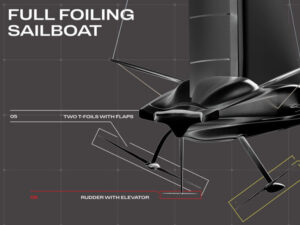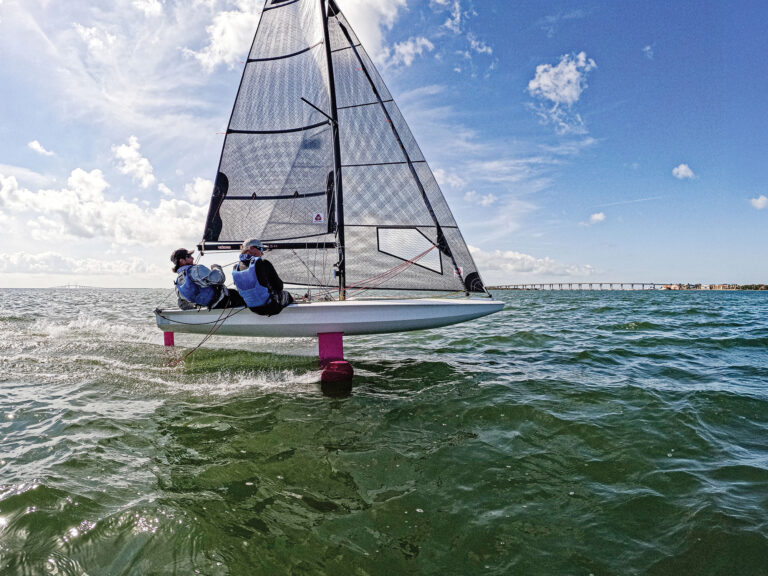
RamblerMain
Over the years, Bob Towse and George David have raced against each other many times on many different boats. The rivalry between these two New York YC members has always been friendly, and the racing, intense. Towse names his boats Blue Yankee, and the latest is a Reichel/Pugh 66-footer built by Compania de Barcos in Argentina in 2005/2006. David’s last two boats were named Idler, but his latest, a 90-foot R/P built in 2002 as Alfa Romeo/Shockwave, is named Rambler. [Students of English philosophy may recognize David’s boat names as the titles of a series of essays by Dr. Samuel Johnson.]The two teams went head-to-head over Memorial Day weekend in the Block Island Race, a 186-mile petite distance race that runs the length of Long Island Sound, around Block Island, and back up the Sound. Rambler sailed the course in 18h:57m:41s, took line honors, and corrected out against the rest of the boats in IRC Super Zero, including Blue Yankee, which placed second by under an hour. Ken Read, whose relationship with David goes back more than a decade and includes a 1999 Admiral’s Cup campaign, skippers Rambler. It’s a good fit, especially now, since Read will lead a team sponsored by Puma in the 2008-2009 Volvo Ocean Race. For the purpose of evaluating potential Volvo crew-and to horse David’s 90-footer around the racecourse-Read has been staffing Rambler with some of the best ocean racers in the world. Read, David, and such well-known sailors as Jerry Kirby, Rick Deppe, Wouter Verbraak, George Peet, Andrew Lewis, Justin Clougher, and Erle Williams will race Rambler in the Nordbank Blue Transatlantic Race later this June. Before it races from Newport, Rhode Island, to Hamburg, Germany, however, Rambler faced off against Blue Yankee at New York YC’s annual regatta, held June 14-16 in Newport. Because Rambler’s transatlantic navigator, Wouter Verbraak, couldn’t make it, I got the nod to fill in as navigator for the weekend. The first event of the NYYC Annual Regatta is known as the “Round the Island Race,” a 16-mile race around Conanicut Island in Narragansett Bay. While not scored as part of the regular series-a series of buoy races held on Saturday and Sunday-it’s highly competitive, and can be a challenge navigationally, especially if the fog rolls in, as it’s apt to do in June in Rhode Island’s cool coastal waters.I had sailed with David as a regular crewmember on two different Idlers since 1995, either as a mastman, navigator, or both, but thinking about navigating Rambler kept me up nights. The 90-footer draws 16 feet and sails upwind at 11 to 12 knots. During one of our practice days, I saw a downwind speed of 20 knots. Things happen quickly at those speeds, as I would discover during the course of the three-day series.I woke up early on the first day of racing and started gathering data. First, the email forecast from Commander’s Weather, then a check of the Sailflow weather site. I printed both forecasts, did the same with the sailing instructions and other race documents, and headed to the boat. I spent an hour loading waypoints into the boat’s tactical software, Expedition, which helped me re-familiarize myself with the program. I’ve used Expedition before, but only on a recent Transatlantic Race, where there was plenty of time to figure out the program’s capabilities. Verbraak and I spent some time during a practice weekend going over the system, and I’d been running simulations on a copy of Expedition I have on my personal navigation laptop. Our class started last, and just before our start Read pointed to tendrils of fog heading our way and asked me if I’d plugged all the marks in and had the ability to get us where we needed to go even in low visibility. “Yup,” I said, trying to make my voice sound as confident as I could. We started with decent visibility, but the further south we headed, the thicker the fog became. A buddy of mine had called me that morning to wish me luck, and to tell me: “If you hit the bricks with that boat, they probably won’t be able to fix it in time for the Transatlantic, so you’d better be careful.” He didn’t know the half of it; running aground was one thing, but we also had to be cautious of our air draft as well. Rambler’s rig tops out at “over 130 feet,” according to the boat’s project manager, Mick Harvey. The problem was a bridge spanning the West Passage of the Bay with a vertical clearance of 134 feet. We’d sailed the course a few weeks before, but we’d doused our headsail, hoisted a bowman up the rig, and approached the bridge with the engine on, ready to bail us out of trouble. If it looked like we weren’t going to make it, we’d power out of the problem. As we sailed through the fleet in lousy visibility, boats would suddenly appear. We’d alter course if necessary, and then quickly pass them by. Just as we approached the low bridge, the fog lightened enough to show us the way to the center span. I breathed a quiet sigh of relief. I trusted that I’d put the waypoint for the center span in the right place, but was perfectly happy to eyeball it. For the remainder of the race we had good visibility, and my only job was to tell Read when it was time to tack because of depth issues.We crossed the finish line first, and waited nearby as our main competition made its way to the line. First blood for the series went to Blue Yankee, which finished 18 minutes after us, but corrected out to win by 3m:35s. We ended up third, as the TP 52 Decision (nee Rosebud), also corrected out over us.The first day of buoy racing was good for Rambler, but bad for its navigator. Tactical software, whether it’s Deckman or Expedition, has a great feature called: What If? Using data from the boat’s instrument package, it can help a navigator make layline calls, determine the favored side of the course, and give time to marks. Unfortunately, I spent most of the first day huddled below in the nav station trying to get What If to work. In the end, it was a simple fix, but it took me a long time to figure out first, what I needed, and second, where to find it. Verbraak preferred Deckman, which the boat also had, and had loaded the boat’s polars into that program. Expedition didn’t have the polars, but once I found and installed them, the program worked like a charm. Making my way humbly to the cockpit at the end of the day, I told Read that we’d have all the things we were missing, navigationally, for the final day of racing. In the meantime, using the Mark 1 eyeball, Read had called good laylines all day, and we had a 2-1 scoreline. So did Towse, but they would lose the tiebreaker, as they had a 1-2 for the day. For the final day of the regatta, the software was operating flawlessly. I was able to give time to go to the starting line, determine the favored side of the course (according to the instruments), and call laylines. Most of them. I missed a big one during the leeward leg to the finish of Race 3 while otherwise occupied with fine-tuning the placement of the leeward mark. “Are we laying the finish line yet?” asked, Ken, who then looked under the boom and saw that we had, in fact, just sailed past the layline. Ouch. I’m not sure what hurt worst, missing the layline call, or earning the ire of the rest of the afterguard. To compound matters, we’d been over early and were catching up to Blue Yankee, to which we owed time and with which we were tied for first. Despite our size and speed, we couldn’t overcome being over early on a six-mile-long racecourse and we ended up sixth for the raceWe were hoping to get in another race, and we did get a start, but the wind died completely and the race was abandoned. With our 130-foot-high sail plan we were doing OK, but the rest of the fleet was going nowhere, slowly. At 2:15, the race committee called it a regatta and we headed in. Blue Yankee won overall with a total of four points, and we were second, with nine. Still, it was a great regatta, and a perfect way to spend the weekend. The Blue Yankee/Rambler rivalry goes on hold until next year, as Rambler will stay in Europe after the Transatlantic for the Fastnet Race in August and the Maxi Yacht Rolex Cup in September. For complete results from the NYYC Annual Regatta, click here.http://nyyc.org/index.cfm?content=sailingevents_details&eventid=136









